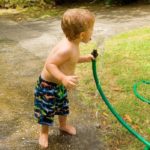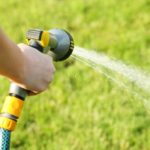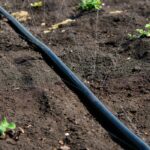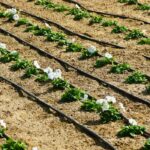Foundation repairs can be incredibly expensive, but you can easily avoid them with a bit of water. Using a soaker hose, you can create a watering system that prevents the soil under your foundation from drying out and contracting during extreme weather.
You should water your foundation with a soaker hose for around 15 to 20 minutes 3-5 times each week in the summer. During drought conditions, let the water run for up to 45 minutes daily. Position the hose in a 3-inch deep trench about 18 inches away from the foundation.
It’s crucial to maintain a constant level of moisture around your house throughout the year for a strong foundation. So let’s look at what exactly a soaker hose is, how you can use it to water your foundation, and whether it’s more effective than a drip irrigation system. That way, you won’t have to worry about your support structure ever again.
What Is a Soaker Hose?
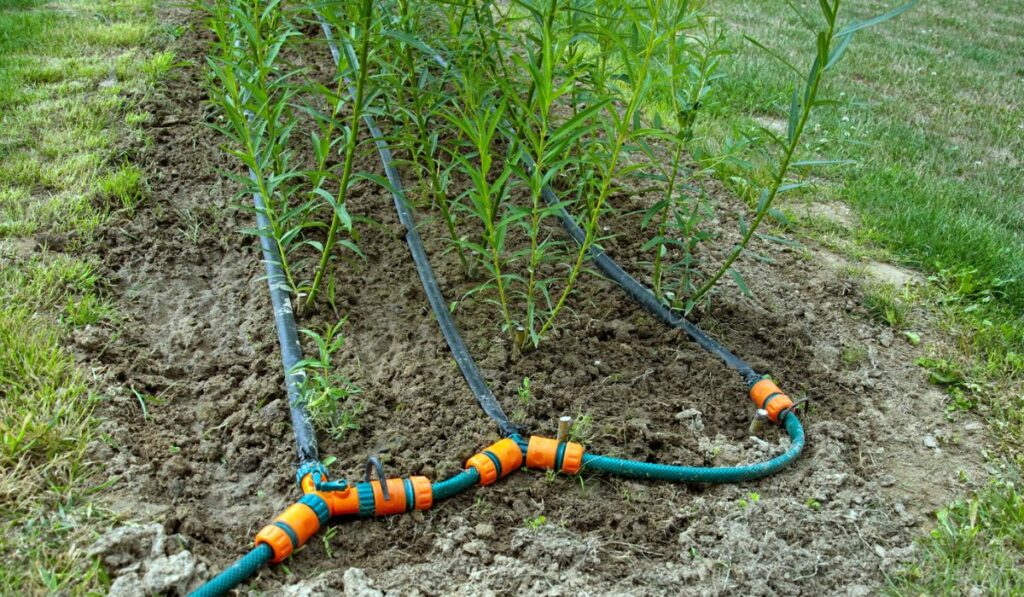
A soaker hose (on Amazon) is an extremely easy and effective solution for controlling ground contraction. The hose has several small holes through which water seeps out into the soil, minimizing evaporation and providing much better coverage than a sprinkler system.
Most soaker hoses are constructed with some mixture of polyethylene plastic and rubber, but a few BPA-free, polyurethane hoses are now available as well.
It’s important to note that a soaker hose only delivers water over the soil where it’s placed. So, if you need to water your lawn as well, then you’ll have to use a combination of sprinklers and soaker hoses for proper coverage.
How to Use a Soaker Hose to Water Your Foundation
The first thing you should do when using a soaker hose is to avoid placing it directly next to your home’s foundation. That’s because the soil around your house will contract and recede from the foundation during periods of extremely high temperatures.
So, if you set up your soaker hose right next to the foundation, too much water might pool under and around the foundation, damaging the support structure.
It’s best to place your soaker hose at least 18 inches away from the foundation, buried in a trench that’s about 3 inches deep. This will ensure that the soil remains moist, but not so much so that it becomes muddy or completely saturated with water.
However, if you still find pools of water in the ground, simply lower the hose’s pressure to fix the problem. If the water continues to pool even after the adjustment, then it might be time to properly aerate your lawn core so that water seeps more than three inches into the ground.
Also, make sure you never set up more than two hoses together at the same time. If you connect multiple soaker hoses to one line, you’ll have uneven water pressure across all the hoses, which means your foundation won’t be watered properly.
Most homeowners prefer using a 3-way or 4-way spigot splitter like this one by Twinkle Star (on Amazon) to run hoses along both sides of the house, leaving additional connections for garden hoses. You can also use a spigot timer (on Amazon) to set how often and long you want to give water to the foundation.
Also, keep in mind that limiting the hose length connected to the spigot increases the water pressure, so it’ll take less time to water the soil. If you have faucets at the back and in front of the house, it’s better to split up the installation.
Where Should You Position Your Soaker Hose?
It’s best to position your soaker hose at least 18 inches away from the foundation or side of your house. Make sure you never try to water your foundation directly, as it could lead to the serious damages we mentioned above.
If your foundation’s already riddled with cracks, the water will pass through them, pooling directly under the grade beam. The grade beam is the thickest and strongest part of a house’s foundation and provides most of the support.
So, if the soil under it becomes saturated, it’ll lose its load-bearing capacity, causing the foundation to become unstable and making the problem much worse. Fortunately, simply placing the soaker hose at a safe distance will ensure that the water seeps into the surrounding soil, strengthening your foundation without hurting it.
It’s also advisable to watch out for any trees nearby, as their roots will spread out to reach the water, placing them dangerously close to the foundation. To prevent the water from reaching the roots, it’s best to install a barrier.
Simply dig up a trench and fill it with something solid, such as plastic sheeting, to stop the roots from growing in that direction. However, if you do want to add trees to your property, then it’s best to consult an arborist or horticulturist first.
Is a Soaker Hose More Effective Than Drip Irrigation?
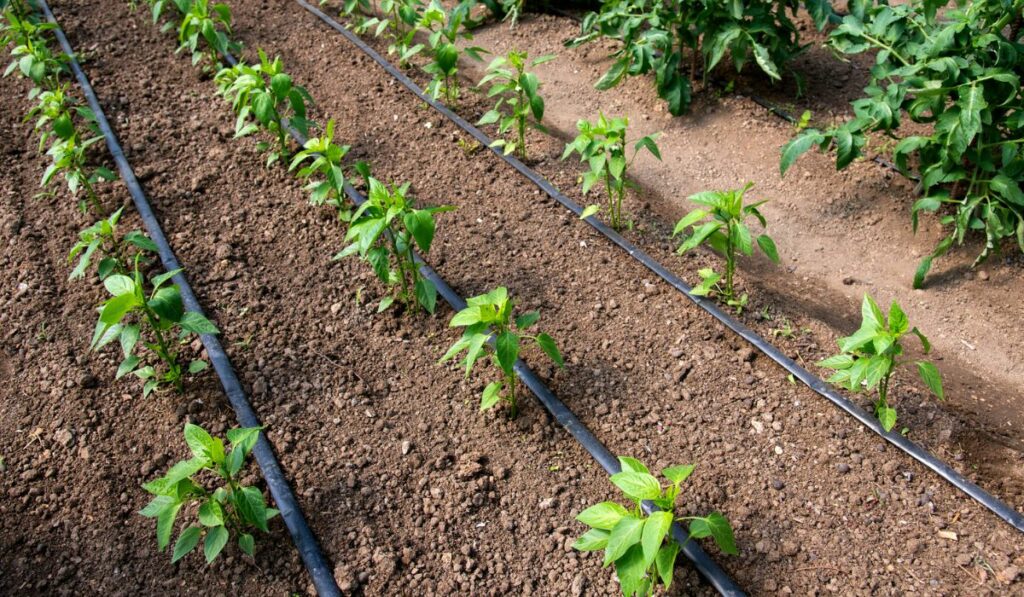
A drip irrigation system isn’t really that effective at strengthening foundations. Since it’s only designed to deliver water to the top four to six inches of soil, the water doesn’t seep deep enough into the soil. It’s also unable to concentrate water near the edges of your home’s foundation, where it’s needed most.
On the other hand, soaker hoses are ideal for use on level ground. They also usually have an inexpensive installation cost, are extremely easy to set up, and can easily be guided around plants.
It’s also important to note that drip emitters only deliver water to a specific spot, while the opposite is true for soaker hoses. Since the water seeps out along the entire length of the soaker hose, you’ll be able to water your foundation more evenly, preventing the water from only pooling in one place.
How Frequently Should You Water Your Foundation?
As a general rule of thumb, you should water more during dry and hot weather and less during damp and cold water. Your goal should be to maintain the level of moisture in the soil such that it stays wet but not dry or soggy.
It’s generally a good idea to provide your lawn and foundation with around one to two inches of water every week. However, if you live in a hotter region, then it’s better to increase the water level to two to three inches every week during the summers.
Keep in mind that this water requirement includes rainwater as well. You can easily measure the amount of water your foundation naturally receives with a rain gauge (on Amazon), and then adjust your watering frequency accordingly.
You can also do a screwdriver test to see if you need to adjust the time you run the hose. Simply stick a screwdriver into the soil. If it comes up dry, you need to give more water, but if there’s mud stuck to it, you’ll have to water less.
Watering your foundation doesn’t typically fall under any local watering restrictions imposed during the summer or times of drought. However, you might be limited to only using your soaker hose at night. If there aren’t any restrictions, then it’s best to run the hose in the early morning to minimize evaporation.
It’s important to note that a soaker hose takes a longer time to completely saturate the soil than a sprinkler system — but it also uses less water. For this reason, it’s best to run your soaker hose for around 15 to 20 minutes every day, 3-5 days a week in the extreme summer heat.
If your area’s suffering from a drought, however, then you might need to increase the watering duration to 45 minutes per day. This should moisten the ground — but not so much so that it turns muddy. After a couple of days, the soil will expand and strengthen the foundation.
What Is the Cost of Installing a Soaker Hose?
Soaker hoses are one of the most inexpensive options for watering the foundation. Of course, installing the hose will depend on the exact length of hose you need, but a standard 50-feet tubing will cost you only around $22.



